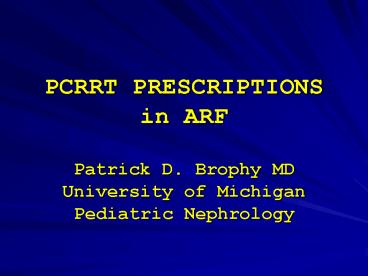PCRRT PRESCRIPTIONS in ARF PowerPoint PPT Presentation
1 / 27
Title: PCRRT PRESCRIPTIONS in ARF
1
PCRRT PRESCRIPTIONSin ARF
- Patrick D. Brophy MD University of Michigan
Pediatric Nephrology
2
Objectives
- Define ARF
- Prescriptions Based on What?
- Case Format
- Modality
- BFR
- UF rate
- Dialysate/FRF rates
- Other issues anticoagulation, access
3
Acute Renal failure
- Definition A life threatening abrupt
cessation/reduction of urinary output to less
than 300ml/m2 caused by prolonged renal ischemia
in most cases (may occasionally present as high
output renal failure- high urinary output with
increasing BUN and Creatinine) - Can lead to severe hypertension (fluid overload)
metabolic abnormalities (acidosis, hyperkalemia)
requiring emergent therapy
4
ARF-- Etiology
- Developing Countries
- Hemolytic-Uremic Syndrome (31)
- Glomerulonephritis (23)
- Post-Op Sepsis/Prerenal ischemia
- Chan et.al. PIR, 232002
- Industrialized Countries
- Intrinsic Renal Disease (44)
- Post-Op Septic Shock (34)
- Organ/Bone Marrow Transplant (13)
5
ARFTreatment Options
- Conservative- fluid management and nutrition
- Renal Replacement Options
- Hemodialysis- Hemodynamic Instability
- Peritoneal Dialysis- efficiency
- CVVH(D)/(DF)- Hemodynamically less volatile than
HD, Can provide optimal fluid and nutritional
management Clearance
6
PEDIATRIC PRESCRIPTION for CRRT
- Classic Case
- 10kg infant (75 cm) BSA0.45m2, high vent
settings-lungs wet, ? sepsis - up 2 kg from dry weight, no urine for 12 hr
- HR 160, BP 80/40 on pressors, pH 7.2
- Creatinine 1.0 mg/dl BUN 40, lactate 4.0,
iCa1.0, K5.8
7
Approach
- This patient clearly is in need of Hemofiltration
- ISSUES Determining the prescription
- CAVH(D)/(DF) vs CVVH(D)/(DF)
- Blood Flow Rate
- Ultrafiltrate (dialysate/FRF rate)
- Access Machinery
- Fluids for dialysate/Filter Replacement
- Anticoagulation
8
CAVH(D) vs CVVH(D)
- CAVH(D)
- Initial form of therapy, Dependent on BP of
patient (difficult to control UF),
Technologically easier (require 2 catheters) - CVVH(D)
- Newer machines, 1 catheter, improved solute
clearance, increased extracorporeal volume,
standard of care
9
Werner et al.,1994, Critical Care Medicine, 22,
320-325
- Goals Evaluation of CVVH using 4 week old lambs
(pediatric size 12.2 kg) - Compared 3 systems postdilution, predilution and
hemofiltration (post-filter replacement) with
counter-current dialysis (standardized UF, BFR
and hemofilter)
10
Werner et al.,1994, Critical Care Medicine, 22,
320-325
11
Werner et al.,1994, Critical Care Medicine, 22,
320-325
- Conclusions
- 1) CVVH(D) feasible in this size group
- 2) Stable blood flow rates from 5-10 ml/kg/min
- 3) BFR in this range with UF rates of 1ml/kg/ min
can produce urea clearance of 1 ml/kg/min
(without causing to large a negative intrafilter
pressure) - 4) dialysis didnt increase urea clearance
(animals not uremic though)
12
Bunchman et al 1995, AJKD, 25,17-21
13
Bunchman et al 1995, AJKD, 25,17-21
14
Bunchman et al 1995, AJKD, 25,17-21
15
Bunchman et al 1995, AJKD, 25,17-21
16
Zobel et al,1991 in Contiuous Hemofiltration.
Contrib Nephrol. V93 pp257-260
17
Dialysate/ Ultrafiltration Rates
- No Study has identified effective, safe UF or
dialysate flow rates in Children. - For HEMODIALYSIS NET UF rate of 0.2ml/kg/min is
tolerated (Donckerwolke Ped Neph
8103-106,1994)-This extrapolates out to 1 ml/kg/
hr (NET UF) over 48 hr of continuous
hemofiltration.
18
Dialysate/ Ultrafiltration Rates
- The UF rate/plasma flow rate BFRx(1-HCT) ratio
should lt 0.35-0.4 in order to avoid filter
clotting (Golper AJKD 6 373-386,1985) - Dialysate flow rates ranging from 10-20 ml/min/m2
(2000ml/1.72m2/hr) are usually adequate
(experiential but consistent with adult data)
19
Ronco et al. Lancet 2000 351 26-30
20
Ronco et al. Lancet 2000 351 26-30
- Conclusions
- Minimum UF rates should reach at least 35
ml/kg/hr - Survivors in all their groups had lower BUNs than
non-survivors prior to commencement of
hemofiltration
21
Access Machinery
- Machinery
- PRISMA, DIAPACT, BAXTER, EDWARDS, FRESENIUS
- Access
- If poor blood flow- no point in continuing!
- Generally want to keep Venous pressure no gt 200
mm Hg - IJ placement preferable (triple lumen ideal!)
- Size based on Patients size
22
Bicarbonate Vs Lactate Fluid
- Commercial vs Custom Solutions For FRF or
Dialysate - Generally Bicarbonate based solutions preferable
(no definitive study to support this- but easier
to interpret lactic acidosis) - FDA approved ie. Normocarb (D only)
- Cost effectiveness pharmacy/nursing costs
23
Anticoagulation
- Heparin
- Citrate
- None
- No good head to head studies comparing Heparin
vs. Citrate in Pediatrics - Center specific and Comfort level
24
Other Considerations
- Nutrition
- CRRT allows optimization of nutritional
supplementation (esp in high catabolic states-
such as ARF)- but it also contributes to a
negative nitrogen balance - Aim for anabolic state- 1.5 g/kg/day protein is
inadequate 2-3 g/kg/day better, with 20-30
increase in caloric intake over resting energy
expenditure - Maxvold et.al. Crit Care Med 282000
25
Recommendations for Pediatric Prescription
- CVVH/CVVHD/CVVHDFD useful when limited by
membrane UF capacity - Pre/Post FRF or Dialysate
- Combined UFdialysate flow rates 10-20 ml/min/m2
(2000ml/1.72m2/hr) INCREASE WITH TOXINS) - At 0.45m2 540ml/hr (exceeds adult
recommendations) - Net UF rate 1 ml/kg/hr
- BFR (4-10 ml/kg/min)-Huge blood flow circulations
in small infants
26
Recommendations Continued
- Access-Dual lumen 8 Fr (triple Lumen if
available) - Bicarbonate based Dialysate or FRF
- Anticoagulation- based on patient circumstance
and center experience - Maximize Nutrition (good communication among
caregivers imperative)
27
- ACKNOWLEDGEMENTS
- MELISSA GREGORY
- ANDREE GARDNER
- JOHN GARDNER
- THERESA MOTTES
- TIM KUDELKA
- LAURA DORSEY BETSY ADAMS

